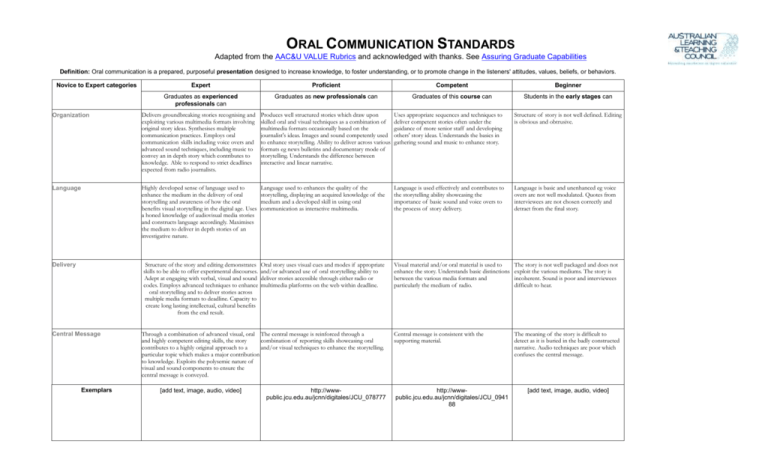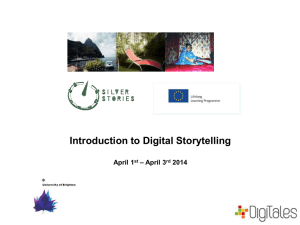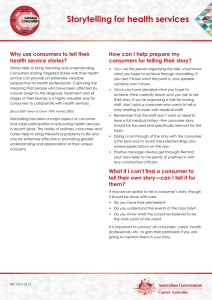Oral communication - Assuring Graduate Capabilities
advertisement

ORAL COMMUNICATION STANDARDS Adapted from the AAC&U VALUE Rubrics and acknowledged with thanks. See Assuring Graduate Capabilities Definition: Oral communication is a prepared, purposeful presentation designed to increase knowledge, to foster understanding, or to promote change in the listeners' attitudes, values, beliefs, or behaviors. Novice to Expert categories Expert Proficient Competent Beginner Graduates as experienced professionals can Graduates as new professionals can Graduates of this course can Students in the early stages can Organization Delivers groundbreaking stories recognising and exploiting various multimedia formats involving original story ideas. Synthesises multiple communication practices. Employs oral communication skills including voice overs and advanced sound techniques, including music to convey an in depth story which contributes to knowledge. Able to respond to strict deadlines expected from radio journalists. Produces well structured stories which draw upon skilled oral and visual techniques as a combination of multimedia formats occasionally based on the journalist's ideas. Images and sound competently used to enhance storytelling. Ability to deliver across various formats eg news bulletins and documentary mode of storytelling. Understands the difference between interactive and linear narrative. Uses appropriate sequences and techniques to deliver competent stories often under the guidance of more senior staff and developing others' story ideas. Understands the basics in gathering sound and music to enhance story. Structure of story is not well defined. Editing is obvious and obtrusive. Language Highly developed sense of language used to enhance the medium in the delivery of oral storytelling and awareness of how the oral benefits visual storytelling in the digital age. Uses a honed knowledge of audiovisual media stories and constructs language accordingly. Maximises the medium to deliver in depth stories of an investigative nature. Language used to enhances the quality of the storytelling, displaying an acquired knowledge of the medium and a developed skill in using oral communication as interactive multimedia. Language is used effectively and contributes to the storytelling ability showcasing the importance of basic sound and voice overs to the process of story delivery. Language is basic and unenhanced eg voice overs are not well modulated. Quotes from interviewees are not chosen correctly and detract from the final story. Delivery Structure of the story and editing demonstrates skills to be able to offer experimental discourses. Adept at engaging with verbal, visual and sound codes. Employs advanced techniques to enhance oral storytelling and to deliver stories across multiple media formats to deadline. Capacity to create long lasting intellectual, cultural benefits from the end result. Oral story uses visual cues and modes if appropriate and/or advanced use of oral storytelling ability to deliver stories accessible through either radio or multimedia platforms on the web within deadline. Visual material and/or oral material is used to enhance the story. Understands basic distinctions between the various media formats and particularly the medium of radio. The story is not well packaged and does not exploit the various mediums. The story is incoherent. Sound is poor and interviewees difficult to hear. Central Message Through a combination of advanced visual, oral The central message is reinforced through a and highly competent editing skills, the story combination of reporting skills showcasing oral contributes to a highly original approach to a and/or visual techniques to enhance the storytelling. particular topic which makes a major contribution to knowledge. Exploits the polysemic nature of visual and sound components to ensure the central message is conveyed. Central message is consistent with the supporting material. The meaning of the story is difficult to detect as it is buried in the badly constructed narrative. Audio techniques are poor which confuses the central message. Exemplars [add text, image, audio, video] http://wwwpublic.jcu.edu.au/jcnn/digitales/JCU_078777 http://wwwpublic.jcu.edu.au/jcnn/digitales/JCU_0941 88 [add text, image, audio, video] Support for this resource has been provided by the Australian Learning and Teaching Council Ltd, an initiative of the Australian Government Department of Education, Employment and Workplace Relations.The views expressed in this resource do not necessarily reflect the views of the Australian Learning and Teaching Council. Last updated May 2011








